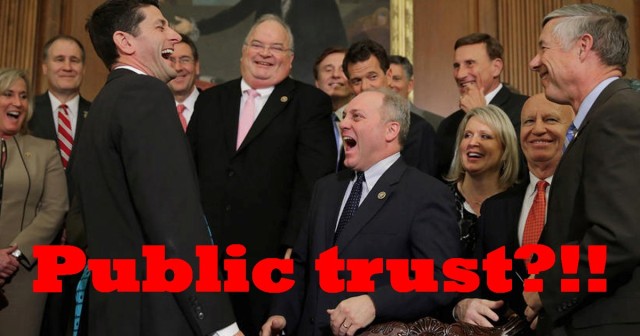Steps to Trustworthiness

Step 1: Someone comes forward and says they want to run for elected office and so want your vote, which is a vote of confidence in that person to not only do a good job but to be trustworthy in it and look out for public interest over private interest. To use the power your vote of confidence gives them, not for personal gain or underhanded business but, to selflessly steer the ship of state to best serve the interests of the public at large.

Step 2: Because people don’t know the candidate or, because their trustworthiness hasn’t been proven in the field of public service, the candidate gives the public information about themselves to win over their trust and confidence to serve. Military service, other offices held, marital lengths are all ways to show the public one’s selfless dedication and commitment to something other than themselves. Although these things are not always fool-proof.

Step 3: When things come up, called ‘conflicts of interest’ that show a benefit to the candidate/official or benefit to their friends or families or those with bias to that candidate/official (self-interest/self-gain), knowing the public’s trust of their behavior is paramount for good, solid, trustworthy governance, the candidate/official wisely, and respectfully, backs away or chooses a different course or removes themself from the thing or situation altogether in order to signal to the public that they are worthy of their sacred trust for their government’s highest gain.
 Step 4: Seeing the candidate/official’s actions toward respecting the public trust over their own self-interests or benefits, the public are free to breathe easier knowing their government’s integrity (and therefore their lives) is on solid footing with the right, and trustworthy, candidate/official.
Step 4: Seeing the candidate/official’s actions toward respecting the public trust over their own self-interests or benefits, the public are free to breathe easier knowing their government’s integrity (and therefore their lives) is on solid footing with the right, and trustworthy, candidate/official.
What undermines and breaks this process down

Step 1: Candidates offer little to no information to a public that doesn’t demand thorough information to make the best choice for their own governance.


Step 2: Low information voters rely on faces and names and yard signs, and not in-depth information, to decide for them. They believe that if a person is in office, they must be there for a reason and therefore, are a ‘good-enough’ candidate to do the job none of them want.

Step 3: Due to citizen’s low-information on elected officials and disinterest in their own governance, officials with little to no personal integrity don’t feel obliged to heed vital conflicts of interest for the public’s trust simply because the public isn’t paying attention anyway. Self-interested scalawags and authoritarians with little to no personal integrity or true care for the public, who didn’t have to prove trustworthiness in order to serve in the first place, now abound at City Hall because they can get away with whatever they want because the public isn’t paying attention.
Step 4: With the annoying nuisance of the public trust no longer in play, officials feel they can rule as they please with overbearing (and un-American) code enforcement, tromping on citizen’s Constitutional rights, profligate spending of taxpayer dollars, open bias and cavalier attitude towards conflicts of interest and the public trust, a damning careless attitude towards the separate branches of our government and an entitled and mocking disregard towards citizens they represent who come to them with peaceable redress of grievances.


You must be logged in to post a comment.